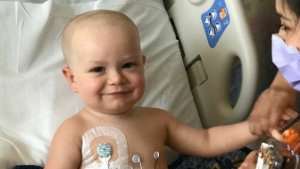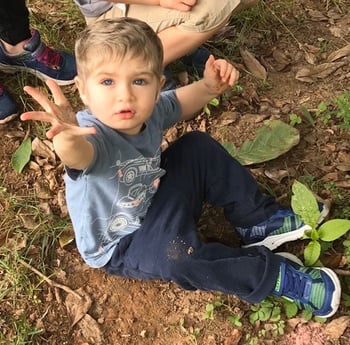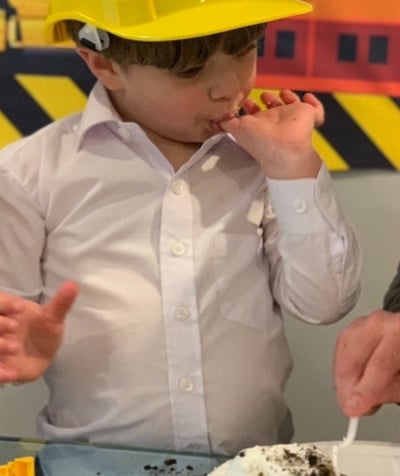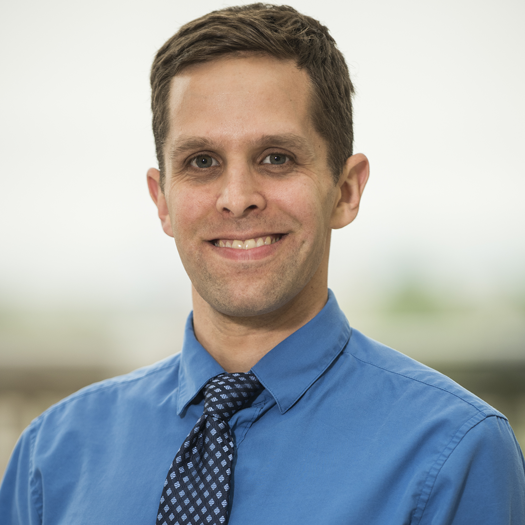
Johan's Story

When Maren Chamorro got the unexpected news that she was pregnant, her mind flashed back to when she was 10 and her little brother, Tommy, was fighting for his life. Tommy had been plagued by repeated and sometimes rare infections since birth and, after nearly one year, the newborn was diagnosed with chronic granulomatous disease (CGD).
The rare disorder saps the immune system’s ability to fend off life-threatening infections. When first described, it was called fatal granulomatous disease because children rarely survived past age 10.
As an X-linked carrier, Maren knew from experience that planning a pregnancy was a serious undertaking.
“When you get pregnant, you’re supposed to get excited. I cried. It was one of those things. I thought ‘OK, I could have a child with CGD,’ “ she recalls. “My brother was almost 8 when he passed away from a disseminated fungal infection. Tommy had a gorgeous life. It was a hard life because of so many hospitalizations, but he was such a gift.”
Still, Tommy’s final hospitalization lasted four months, included 9 major surgeries and a lot of pain. Somber memories of that time guided some of the couple’s choices for Johan.
Relying on faith and proactively planning
During pregnancy, Maren contacted an expert from the National Institutes of Health (NIH) who had answered her emailed questions about the disease years earlier. Meanwhile, her husband, Ricardo, started researching the disease in order to begin assembling a game plan, just in case.
That proactive planning included coordinating with a geneticist to test Johan for CGD right after birth. Three decades after Tommy’s death, Maren was with her parents, Jane and Mike Wipf, when the family was told Johan had CGD.
“That was really hard news to receive,” she says through tears. “It’s not easy to have to relive a disease you hate so much. But, we kicked our game plan into motion.”

Her geneticist was trying to schedule an appointment with Michael Keller, MD, a pediatric immunologist at Children’s National Hospital who specializes in primary immunity disorders.
“I’m very much a doer with my children. I emailed Harry Malech, MD, at the NIH that night. He emailed me right back, copying his team and including Dr. Keller. Dr. Keller called me at my home on Sunday and said ‘We’re here for you. We’re going to get you in this week.’ I cannot tell you how much I appreciate him and all of the Children’s National team,” she says.
“We saw Dr. Keller that week. He had to deal with a mom who was not only coping with a rare disease but also reliving the post-traumatic stress from dealing with that disease as a child.”
Dr. Keller also started Johan on itraconazole, a heavy-duty antifungal. Tommy had received itraconazole late in life, vials sent from Belgium through a compassionate use exemption. Now, that same drug became part of Johan’s daily regimen, along with Bactrim, a combination antibiotic.
A key element of the couple’s game plan to safeguard Johan’s health included a bone marrow transplant.
“My husband talked to me about it during pregnancy. We tried to think about every possibility: At the time I was pregnant, he just said it was the only thing that will cure CGD - which is true,” she says.
Dr. Keller also introduced the family to Blachy Dávila Saldaña, MD, to learn more about the bone marrow transplant option. And, because Ricardo’s research revealed that the best outcomes occurred with children who had no infections prior to transplant, the family tried their utmost to make sure Johan was healthy before his April 2018 procedure. Because mold can bloom in mulch - and four brothers with CGD they know wound up in the hospital when they tried to mow their own lawn – they did their best to keep Johan away from such environmental risks.
Three giant high-efficiency particulate air filters hummed as they breathed in their home’s indoor air, trapping and filtering out potential triggers. And a steamer was on standby. Every member of the family played a part to ensure Johan had the best chance of success before and after the transplant.
“My parents pretty much moved here, on and off, for a year. They took on the roles of mom and dad,” she explains.
The procedure would occur when Johan was about 18 months old, after the flu season peak, timing that accounted for how much school time would remain for the couple’s older children, 6-year-old fraternal twins. (The twins left school 14 days early to spend more than a month in Alaska with her sister, Kristin, and their four cousins.)
Adding new chapters to Johan’s life
Johan’s older sister, Joanna, was a “love” donor. His older brother, Thomas, (named after the uncle who died from the same disease), was the “supercell” donor, donating bone marrow to save Johan’s life.
“If you draw a circle, we have completed the circle - from my brother to Johan. It’s pretty incredible,” she says. “When people talk about the term ‘full circle,’ we can complete that circle. It’s kind of like a big hug.”
And in the three decades since Tommy died, immunotherapy has revolutionized how such dread diseases are conquered, allowing families to add new chapters to their children’s lives. In Johan’s case, the bone marrow transplant performed by Dr. Saldaña and his team rebuilt the toddler’s immune system, saving his life by providing a constantly renewing supply of disease-fighting cells.

“They not only held our hands throughout, Dr. Dávila and his team went above and beyond being clinical doctors. That’s what Children’s National does so well: They help parents who are so concerned about fighting for life and making sure you make the right decisions,” she adds.
Johan’s bone marrow transplant was followed by a specialized T-cell infusion to fight a half dozen of the most common infections that can cause a transplant to fail.
“It’s really great to think Johan has some active immunity from his brother,” Maren says.
The couple strategized ways to continue protecting Johan after his transplant. The couple’s twins were home schooled for months to lessen the chance of an infection hitching a ride home to a toddler who had a penchant for putting everything into his mouth.
“They bring home every single germ imaginable. When you have a central line infection, you’re in the hospital for at least two days,” she says.
Johan has had only two hospitalizations post-transplant. And on Nov. 11, 2019, he turned 3.
“He is doing fantastic. He’s back to his normal weight, thanks to oatmeal with M&Ms. At his last appointment, he was given the green light to go to school,” she says.
In addition to the Mommy and Me preschool class he will attend two to three days a week, Johan has been able to explore the big outdoors, including a visit to a water park and trips to neighborhood parks, where he loves to play in the dirt.
“He is doing great. He is loving life. He is loving exploring life,” she says. “Because we were so isolated, it’s all new. It’s all exciting. He especially loves construction stuff.”
Johan’s birthday party had a construction theme. The kids wore fluorescent orange vests and canary yellow heavy construction equipment graced his birthday cake.
“We are really grateful for the now. I think of his future no differently than I do for my other two kids,” Maren says. “He is going to have the same normal life issues, which we look forward to. I love that we get to experience life together. It affects you when you have a restrictive illness. We are very grateful we can be outside. We can do things. We are not taking that part of life for granted.”




